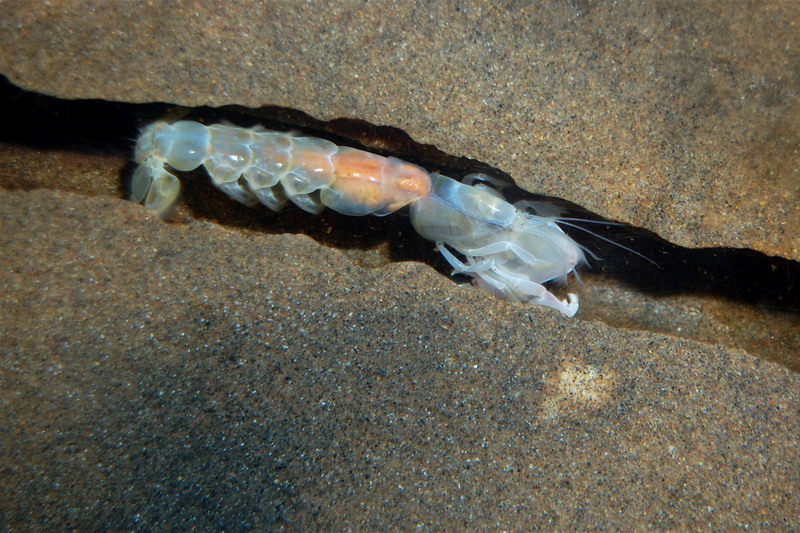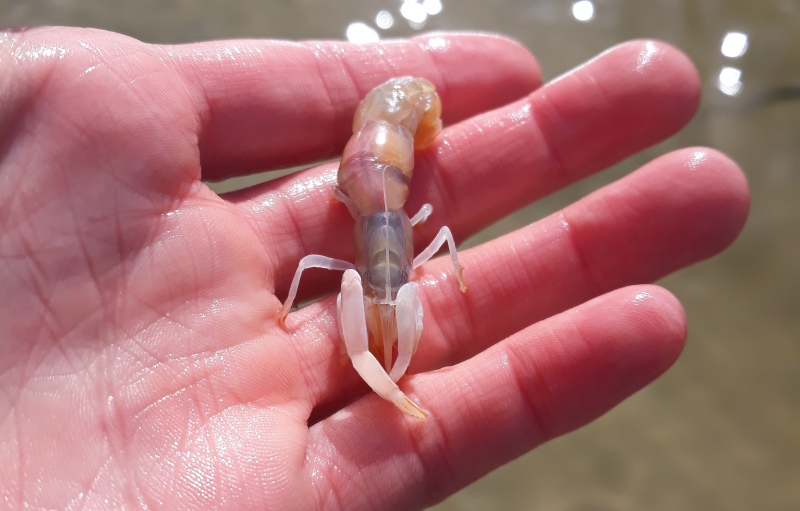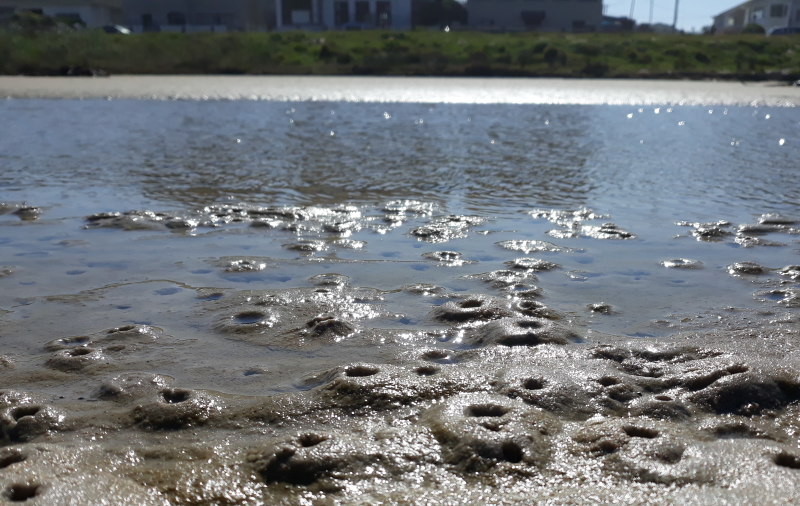Humble sandprawn: a champion water filterer
26 February 2020 | Story Birgit Ottermann. Read time >10 min.
The unassuming little sandprawn, invisible to many and best known as bait for fishing, has been cast into the international spotlight by three UCT researchers who discovered its ability to filter coastal water, thus combatting eutrophication – one of the major water quality challenges in the natural world.
“Eutrophication is a huge problem globally,” says Dr Deena Pillay, senior lecturer in UCT’s Department of Biological Sciences. “As human populations increase, a lot of the waste is going into the rivers and the sea. But before it reaches the sea, the waste passes into estuaries, which have become collection points of human nutrients.
“This waste can come from farms and gardens (such as fertilisers), informal settlements and untreated sewage from treatment facilities.”
“We discovered that the common sandprawn improves water quality by removing microscopic algae.”
Eutrophication causes an overgrowth of algae that harms water quality, reduces oxygen, produces toxins, impacts marine life, and, ultimately, affects our food and human health.
“We discovered that the common sandprawn (Callichirus kraussi) that occurs in estuaries all along the southern African coast improves water quality by removing microscopic algae,” says Olivia Venter, who researched the sandprawn for her master’s degree in conservation biology, with Pillay as her supervisor. “This prevents eutrophication: the excess of algal growth in a water body.”
Earthworms of the ocean
According to Pillay, sandprawns are renowned burrowers that can dig deep into the ocean floor.
“They are considered the most important sedimentary workers in the marine world. Think of them as the earthworms of the ocean, but they are much more active and productive – turning, mixing and aerating sand at a much higher rate.”
Pillay is a marine biologist who specialises in marine sedimentary ecosystems, and organisms that burrow and live at the bottom of the ocean, estuaries and lagoons. He studied the sandprawn in depth for his PhD at the University of KwaZulu-Natal (with Professor Anthony Forbes and Emeritus Professor George Branch as his supervisors) and has continued this interest as an academic at UCT.

Interestingly, Venter has a background in chemical engineering and did her honours project on water quality in mining processes. Her desire to properly understand the effects people have on the environment – so that she can use her engineering skills to find truly environmentally sustainable solutions – led to her master’s in conservation biology.
“From an engineering point of view, I knew that the fact that sandprawns have such a big influence on the sediment meant that they were very likely to also have an indirect influence on the water quality above their burrows,” she recalls.
To test this idea, Venter and Pillay developed an experimental setup of sediment – in which the prawns could burrow – and water, containing microscopic marine algae called phytoplankton. They introduced sandprawns to the setup and then monitored the water quality.
They were surprised by what happened next.
The sandprawns quickly reduced the amount of algae in the system by 50% – much more than they had expected. And long-term results from the field – at Zandvlei Estuary in Cape Town – showed the little crustacean’s impact in the wild to be even greater.
“What really surprised us was the speed and magnitude at which this water filtration happened.”
“We discovered that areas with sandprawns had 70% less phytoplankton than other adjacent areas in the estuary where there were no sandprawns,” says Kervin Prayag, a master’s student at UCT’s Department of Biological Sciences who assisted with statistical analyses.
“What really surprised us was the speed and magnitude at which this water filtration happened,” Pillay adds. “After just four days, we could already see how the water was being cleared by the sandprawns’ burrowing.”
So, how do sandprawns filter water?
“They do so as a result of their burrowing activities,” Pillay explains. “The prawns’ water pumping creates a stream that drives the phytoplankton from the water above into the burrows. This then gets trapped on the burrow walls and becomes a food source for the sandprawns.”

Novel research with global significance
The new findings of Venter, Pillay and Prayag’s research resulted in their paper being published by the prestigious Nature Group’s journal Scientific Reports.
“This is the first time that the significance of the connection between the burrowing of sandprawns and the filtering of water has been made clear. And since sandprawns can be found in great numbers across the world, they can be used as nature-based solutions to coastal eutrophication on a global scale and should be protected because of that,” Pillay continues.
“This is the first time that the significance of the connection between the burrowing of sandprawns and the filtering of water has been made clear.”
The main threats to sandprawns, globally, are people harvesting them as fish bait – which disturbs both their population and burrows – and the destruction of their habitat in estuaries and bays through development and the conversion of soft sand into hard structures like canals.
“Once you put a concrete layer over the sand, all of the burrowing creatures that filter the water cannot do so anymore,” says Pillay. “Many of the estuaries in South Africa, especially in our urban areas, have been canalised to some degree to stabilise the area at times of flooding.
“A possible solution for this could be to create a honeycomb-effect in the canal, where you have some openings that allow sandprawns to continue their activity while still providing some stabilisation.”
Venter points out how important it is to understand the different ways in which we benefit from nature.
“Sandprawns are impacting ecosystems on a large scale. It is important to understand and appreciate how they improve our water quality.”
“If we want to ensure a healthy and sustainable environment in which nature and people can thrive, we need to conserve the natural processes from which we benefit and actually depend on – even if we are not aware of them.
“Sandprawns are impacting ecosystems on a large scale. It is important to understand and appreciate how they improve our water quality and to ensure that we conserve them and their water purification service.”
- Venter O et al. (2020) Water filtration by burrowing sandprawns provides novel insights on endobenthic engineering and solutions for eutrophication. Scientific Reports. https://doi.org/10.1038/s41598-020-58677-1
 This work is licensed under a Creative Commons Attribution-NoDerivatives 4.0 International License.
This work is licensed under a Creative Commons Attribution-NoDerivatives 4.0 International License.
Please view the republishing articles page for more information.










